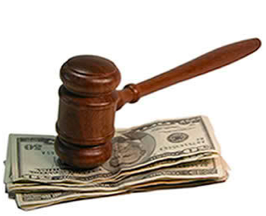Types of Malpractice Lawsuit Damages
by
When a malpractice case comes before a court, understanding the complexities involved with evidence, testimony, legal precedents, and damages, if any, can be overwhelming to a non-attorney.
For example there are different kinds of damages including compensatory and punitive.
Compensatory damages are intended to compensate the victim for his or her loss, pain and suffering, future losses, etc. Punitive damages or exemplary damages are damages intended to reform or deter the defendant and others from engaging in conduct similar to that which formed the basis of the lawsuit. Although the purpose of punitive damages is not to compensate the plaintiff, the plaintiff will receive all or some portion of the punitive damage award.
Punitive damages are often awarded where compensatory damages are deemed an inadequate remedy. The court may impose them to prevent under-compensation of plaintiffs, to allow redress for undetectable torts and taking some strain away from the criminal justice system.
Each state has different guidelines for what kinds of damages are allowed, and how the amounts are determined. The Connecticut Law Tribune recently submitted a good argument for why punitive damages should be increased in that state:
By Brendan Faulkner and Michael A. D’Amico – Punitive damages may be imposed under the common law or specific statutory provisions when a defendant is found to have caused harm by its reckless, wanton or willful conduct. The idea behind punitive damages is that when people or corporations engage in outrageous civil misconduct, they should be required to pay not only the actual damages their conduct causes, but an additional penalty as punishment and deterrence to them and others.
Punitive damages also often serve to correct the imbalance between the parties, acknowledge the worth of the victim, promote public health and safety, and allow juries to be the voice of the community. Sometimes punitive damages need to be large to be effective; for instance, where the defendant is a large corporation with assets and revenue such that an award of even hundreds of thousands of dollars would be insignificant. This is where Connecticut’s punitive damages laws fall short, and are in need of change.
Under Connecticut common law, punitive damages are frequently limited to litigation costs and attorney fees. This derives from an antiquated (and misguided) conception in Connecticut’s case law that punitive damages serve a limited compensatory purpose. This is at odds with the majority of the jurisprudence on punitive damages, which holds that the functions are punishment and deterrence. The notion that they are compensatory nonetheless remains alive here, and leaves Connecticut residents unnecessarily exposed. Full story @ CTLawTribune.com
MalpracticeAttorneys.com is one of the largest online sources for recent, accurate news and information about malpractice cases and malpractice law. Our service is free for victims of any kind of malpractice, and the attorneys we recommend are highly qualified to advise, mediate, and litigate if necessary on your behalf. Registering on our site is easy, and after you’re signed up you may expect a prompt call from our knowledgeable and helpful staff.
Keywords:
Connecticut Malpractice Attorney
Connecticut Malpractice Law
MalpracticeAttorneys.com
Malpractice Damages


